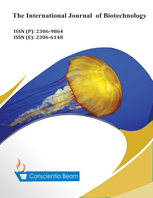Performance Evaluation of Hybrid Upflow Anaerobic Sludge Blanket Reactor in the Treatment of Dairy Waste Water
Abstract
Dairy industries have shown tremendous growth in size and number in most countries of the world. These industries discharge wastewater which is characterized by high chemical oxygen demand, biological oxygen demand, nutrients, and organic and inorganic contents. Such wastewaters, if discharged without proper treatment, severely pollute receiving water bodies. For treatment of dairy waste water, several physical, chemical and biological methods are available. However, dairy waste responds best to the biological processes the heavily aerated effluent is brought in contact with microorganisms, which oxidize its organic matter to carbon dioxide and water. In anaerobic processes, the microorganisms convert organic matter to biogas and cell biomass. To start with a digester was inoculated with 10%of volume of the reactor and the remaining space was filled with dairy waste water with an organic loading rate of 2.5g/l/day, 3.0g/l/day and 3.5g/l/day and was acclimatized for the development of microbial population and 10% of the reactor was left for gas collection.

